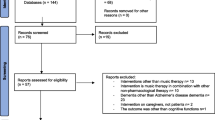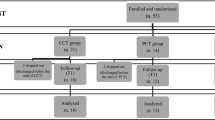Abstract
The current drug treatment for Alzheimer’s disease (AD) is only partially and temporary effective. Transcranial magnetic stimulation (TMS) is a non-invasive technique that generates an electric current inducing modulation in cortical excitability. In addition, cognitive training (COG) may improve cognitive functions in AD. Our aim was to treat AD patients combining high-frequency repetitive TMS interlaced with COG (rTMS-COG). Eight patients with probable AD, treated for more than 2 months with cholinesterase inhibitors, were subjected to daily rTMS-COG sessions (5/week) for 6 weeks, followed by maintenance sessions (2/week) for an additional 3 months. Six brain regions, located individually by MRI, were stimulated. COG tasks were developed to fit these regions. Primary objectives were average improvement of Alzheimer Disease Assessment Scale-Cognitive (ADAS-cog) and Clinical Global Impression of Change (CGIC) (after 6 weeks and 4.5 months, compared to baseline). Secondary objectives were average improvement of MMSE, ADAS-ADL, Hamilton Depression Scale (HAMILTON) and Neuropsychiatric Inventory (NPI). One patient abandoned the study after 2 months (severe urinary sepsis). ADAS-cog (average) improved by approximately 4 points after both 6 weeks and 4.5 months of treatment (P < 0.01 and P < 0.05) and CGIC by 1.0 and 1.6 points, respectively. MMSE, ADAS-ADL and HAMILTON improved, but without statistical significance. NPI did not change. No side effects were recorded. In this study, rTMS-COG (provided by Neuronix Ltd., Yokneam, Israel) seems a promising effective and safe modality for AD treatment, possibly as good as cholinesterase inhibitors. A European double blind study is underway.



Similar content being viewed by others
References
Beach TG, Kuo YM, Spiegel K, Emmerling MR, Sue LI, Kokjohn K, Roher AE (2000) The cholinergic deficit coincides with Abeta deposition at the earliest histopathologic stages of Alzheimer disease. J Neuropathol Exp Neurol 59(4):308–313
Bellgowan PS, Buffalo EA, Bodurka J, Martin A (2009) Lateralized spatial and object memory encoding in entorhinal and perirhinal cortices. Learn Mem 16(7):433–438
Belmaker RH, Grisaru N (1998) Magnetic stimulation of the brain in animal depression models responsive to ECS. J ECT 14(3):194–205
Berlingeri M, Crepaldi D, Roberti R, Scialfa G, Luzzatti C, Paulesu E (2008) Nouns and verbs in the brain: grammatical class and task specific effects as revealed by fMRI. Cogn Neuropsychol 25(4):528–558
Birks J (2006) Cholinesterase inhibitors for Alzheimer’s disease. Cochrane Database Syst Rev 1:CD005593. doi:10.1002/14651858.CD005593
Birks J, Grimley Evans J, Iakovidou V, Tsolaki M, Holt FE (2009) Rivastigmine for Alzheimer’s disease. Cochrane Database Syst Rev 2:CD001191. doi:10.1002/14651858.CD001191.pub2
Bliss TV, Collingridge GL (1993) A synaptic model of memory: long-term potentiation in the hippocampus. Nature 361(6407):31–39
Bohning DE, Shastri A, McConnell KA, Nahas Z, Lorberbaum JP, Roberts DR, Teneback C, Vincent DJ, George MS (1999) A combined TMS/fMRI study of intensity-dependent TMS over motor cortex. Biol Psychiatr 45(4):385–394
Bohning DE, Shastri A, Wassermann EM, Ziemann U, Lorberbaum JP, Nahas Z, Lomarev MP, George MS (2000) BOLD-f MRI response to single-pulse transcranial magnetic stimulation (TMS). J Magn Resonance Imaging 11(6):569–574
Boroojerdi B, Phipps M, Kopylev L, Wharton CM, Cohen LG, Grafman J (2001) Enhancing analogic reasoning with rTMS over the left prefrontal cortex. Neurology 56(4):526–528
Braun M, Finke C, Ostendorf F, Lehmann TN, Hoffmann KT, Ploner CJ (2008) Reorganization of associative memory in humans with long-standing hippocampal damage. Brain 131(Pt 10):2742–2750
Brookmeyer R, Johnson E, Ziegler-Graham K, Arrighi HM (2007) Forecasting the global burden of Alzheimer’s disease. Alzheimers Dement 3(3):186–191
Buck BH, Black SE, Behrmann M, Caldwell C, Bronskill MJ (1997) Spatial- and object-based attentional deficits in Alzheimer’s disease. Relationship to HMPAO-SPECT measures of parietal perfusion. Brain 120(Pt 7):1229–1244
Cooke SF, Bliss TV (2006) Plasticity in the human central nervous system. Brain 239(Pt 7):1659–1673
Cotelli M, Manenti R, Cappa SF, Geroldi C, Zanetti O, Rossini PM, Miniussi C (2006) Effect of transcranial magnetic stimulation on action naming in patients with Alzheimer disease. Arch Neurol 63(11):1602–1604
Cummings JL, Mega M, Gray K, Rosenberg-Thompson S, Carusi DA, Gornbein J (1994) The Neuropsychiatric Inventory: comprehensive assessment of psychopathology in dementia. Neurology 44(12):2308–2314
Fleischmann A, Hirschmann S, Dolberg OT, Dannon PN, Grunhaus L (1999) Chronic treatment with repetitive transcranial magnetic stimulation inhibits seizure induction by electroconvulsive shock in rats. Biol Psychiatry 45(6):759–763
Foerster S, Buschert VC, Buchholz HG, Teipel SJ, Zach C, Bartenstein P, Buerger K (2009) Positive effects of a 6-month stage-specific cognitive intervention program on brain metabolism in subjects with amnestic mild cognitive impairment (aMCI) and mild Alzheimer’s Disease (AD). Alzheimers Dementia 5(4 Suppl 1):38
Folstein MF, Folstein SE, McHugh PR (1975) Mini-mental state. A practical method for grading the cognitive state of patients for the clinician. J Psychiatr Res 12(3):189–198
Fratiglioni L, Launer LJ, Andersen K, Breteler MM, Copeland JR, Lobo A, Martinez-Lage J, Soininen H, Hofman A (2000) Incidence of dementia and major subtypes in Europe: A collaborative study of population-based cohorts. Neurol Dis Elderly Res Group 54(11 Suppl 5):S10–15
George MS, Lisanby SH, Avery D, McDonald WM, Durkalski V, Pavlicova M, Anderson B, Nahas Z, Bulow P, Zarkowski P, Holtzheimer PE 3rd, Schwartz T, Sackeim HA (2010) Daily left prefrontal transcranial magnetic stimulation therapy for major depressive disorder: a sham-controlled randomized trial. Arch General Psychiatr 67(5):507–516
Giacobini E (1990) The cholinergic system in Alzheimer disease. Prog Brain Res 84:321–332
Grafman J, Pascual-Leone A, Alway D, Nichelli P, Gomez-Tortosa E, Hallett M (1994) Induction of a recall deficit by rapid-rate transcranial magnetic stimulation. Neuroreport 5(9):1157–1160
Grossman M, Rhee J (2001) Cognitive resources during sentence processing in Alzheimer’s disease. Neuropsychologia 39(13):1419–1431
Grossman M, Koenig P, DeVita C, Glosser G, Alsop D, Detre J, Gee J (2002) The neural basis for category-specific knowledge: an fMRI study. Neuroimage 15(4):936–948
Guse B, Falkai P, Wobrock T (2010) Cognitive effects of high-frequency repetitive transcranial magnetic stimulation: a systematic review. J Neural Transm 117(1):105–122
Guy W (1976) Clinical global impressions. In: ECDEU assessment manual for psychopharmacology, revised (DHEW Publ No ADM 76–338). National Institute of Mental Health, Rockville, pp 218–222
Hamidi M, Tononi G, Postle BR (2008) Evaluating the role of prefrontal and parietal cortices in memory-guided response with repetitive transcranial magnetic stimulation. Neuropsychologia 47(2):295–302
Hamilton M (1980) Rating depressive patients. J Clin Psychiatr 41(12 Pt 2):21–24
Hao J, Li K, Li K, Zhang D, Wang W, Yang Y, Yan B, Shan B, Zhou X (2005) Visual attention deficits in Alzheimer’s disease: an fMRI study. Neurosci Lett 385(1):18–23
Harpaz Y, Levkovitz Y, Lavidor M (2009) Lexical ambiguity resolution in Wernicke’s area and its right homologue. Cortex 45(9):1097–1103
Hebert LE, Scherr PA, Bienias JL, Bennett DA, Evans DA (2003) Alzheimer disease in the US population: prevalence estimates using the 2000 census. Arch Neurol 60(8):1119–1122
Hyman BT, Damasio H, Damasio AR, Van Hoesen GW (1989) Alzheimer’s disease. Annu Rev Public Health 10:115–140
Julkunen P, Jauhiainen AM, Westerén-Punnonen S, Pirinen E, Soininen H, Könönen M, Pääkkönen A, Määttä S, Karhu J (2008) Navigated TMS combined with EEG in mild cognitive impairment and Alzheimer’s disease: a pilot study. J Neurosci Methods 172(2):270–276
Kimbrell TA, Little JT, Dunn RT, Frye MA, Greenberg BD, Wassermann EM, Repella JD, Danielson AL, Willis MW, Benson BE, Speer AM, Osuch E, George MS, Post RM (1999) Frequency dependence of antidepressant response to left prefrontal repetitive transcranial magnetic stimulation (rTMS) as a function of baseline cerebral glucose metabolism. Biol Psychiatr 46(12):1603–1613
Lisanby SH, Luber B, Perera T, Sackeim HA (2000) Transcranial magnetic stimulation: applications in basic neuroscience and neuropsychopharmacology. Int J Neuropsychopharmacol 3(3):259–273
Mantovani A, Lisanby SH (2004) Applications of transcranial magnetic stimulation to therapy in psychiatry. Psychiatr Times 21(9)
Mecocci P, Bladstrom A, Stender K (2009) Effects of memantine on cognition in patients with moderate to severe Alzheimer’s disease: post-hoc analyses of ADAS-cog and SIB total and single-item scores from six randomized, double-blind, placebo-controlled studies. Int J Geriatr Psychiatr 24(5):532–538
Nakamura H, Kitagawa H, Kawaguchi Y, Tsuji H (1997) Intracortical facilitation and inhibition after transcranial magnetic stimulation in conscious humans. J Physiol 498(Pt 3):817–823
Nixon P, Lazarova J, Hodinott-Hill I, Gough P, Passingham R (2004) The inferior frontal gyrus and phonological processing: an investigation using rTMS. J Cogn Neurosci 16(2):289–300
Onder G, Zanetti O, Giacobini E, Frisoni GB, Bartorelli L, Carbone G, Lambertucci P, Silveri MC, Bernabei R (2005) Reality orientation therapy combined with cholinesterase inhibitors in Alzheimer’s disease: randomised controlled trial. Br J Psychiatry 187:450–455
Orrell M, Spector A, Thorgrimsen L, Woods B (2005) A pilot study examining the effectiveness of maintenance Cognitive Stimulation Therapy (MCST) for people with dementia. Int J Geriatr Psychiatr 20:446–451
Perry EK, Perry RH, Blessed G, Tomlinson BE (1977) Necropsy evidence of central cholinergic deficits in senile dementia. Lancet 1(8004):189
Plassman BL, Langa KM, Fisher GG, Heeringa SG, Weir DR, Ofstedal MB, Burke JR, Hurd MD, Potter GG, Rodgers WL, Steffens DX, Willis RJ, Wallace RB (2007) Prevalence of dementia in the United States: the aging, demographics, and memory study. Neuroepidemiology 29(1–2):125–132
Robinson DM, Keating GM (2006) Memantine: a review of its use in Alzheimer’s disease. Drugs 66(11):1515–1534
Rogalsky C, Matchin W, Hickok G (2008) Broca’s area, sentence comprehension, and working memory: an fMRI Study. Front Hum Neurosci 2:14
Rogers SL, Friedhoff LT (1996) The efficacy and safety of donepezil in patients with Alzheimer’s disease: results of a US Multicentre, Randomized, Double-Blind, Placebo-Controlled Trial. The Donepezil Study Group. Dementia 7(6):293–303
Rosen WG, Mohs RC, Davis KL (1984) A new rating scale for Alzheimer’s disease. Am J Psychiatr 141(11):1356–1364
Rossi S, Hallett M, Rossini PM, Pascual-Leone A (2009) Safety, ethical considerations, and application guidelines for the use of transcranial magnetic stimulation in clinical practice and research. Clin Neurophysiol 120(12):2008–2039
Siebner HR, Rothwell J (2003) Transcranial magnetic stimulation: new insights into representational cortical plasticity. Exp Brain Res 148(1):1–16
Sitzer DI, Twamley EW, Jeste DV (2006) Cognitive training in Alzheimer’s disease: a meta-analysis of the literature. Acta Psychiatr Scand 114(2):75–90
Spector A, Thorgrimsen L, Woods B, Royan L, Davies S, Butterworth M, Orrell M (2003) Efficacy of an evidence-based cognitive stimulation therapy programme for people with dementia: randomised controlled trial. Br J Psychiatr 183:248–254
Stern Y (2002) What is cognitive reserve? Theory and research application of the reserve concept. J Int Neuropsychol Soc 8(3):448–460
Tárraga L, Boada M, Modinos G, Espinosa A, Diego S, Morera A, Guitart M, Balcells J, Lopez OL, Becker JT (2006) A randomised pilot study to assess the efficacy of an interactive, multimedia tool of cognitive stimulation in Alzheimer’s disease. J Neurol Neurosurg Psychiatr 77(10):1116–1121
Thickbroom GW (2007) Transcranial magnetic stimulation and synaptic plasticity: experimental framework and human models. Exp Brain Res 180(4):583–593
van Duijn CM (1996) Epidemiology of the dementias: recent developments and new approaches. J Neurol Neurosurg Psychiatr 60(5):478–488
Wassermann EM, Grafman J, Berry C, Hollnagel C, Wild K, Clark K, Hallett M (1996) Use and safety of a new repetitive transcranial magnetic stimulator. Electroencephalogr Clin Neurophysiol 101(5):412–417
Zheng XM (2000) Regional cerebral blood flow changes in drug-resistant depressed patients following treatment with transcranial magnetic stimulation: a statistical parametric mapping analysis. Psychiatr Res 100(2):75–80
Acknowledgment
We wish to thank Dr. Moshe Faran PhD for his professional assistance, Dr. Shai Efrati MD for his support, Dr. Ilana Galantner PhD for performing the statistical analysis, Dr. Puzhevsky MD for performing the MRI anatomical determinations, and Dr. Carmiya Weingarten-Baror PhD for drafting the article.
Conflict of interest
Neuronix Ltd, Yokneam, Israel, financially supported this study through the Department of Research of Assaf-Harofeh Medical Center, Israel. Prof. Rabey is a consultant for Neruronix Ltd. He is also Chairman of the Steering Committee for the European multi-center research sponsored by Neuronix Ltd. Jonathan Bentwich was an employee of Neuronix Ltd.
Author information
Authors and Affiliations
Corresponding author
Rights and permissions
About this article
Cite this article
Bentwich, J., Dobronevsky, E., Aichenbaum, S. et al. Beneficial effect of repetitive transcranial magnetic stimulation combined with cognitive training for the treatment of Alzheimer’s disease: a proof of concept study. J Neural Transm 118, 463–471 (2011). https://doi.org/10.1007/s00702-010-0578-1
Received:
Accepted:
Published:
Issue Date:
DOI: https://doi.org/10.1007/s00702-010-0578-1




